Category: Pets
Identification Des Chiens: Cartes, Puces, Et Colliers Pour La Sécurité De Votre Animal Ou Animal

Les Une laisse pour chien pour chiens et chats ne sont pas seulement des objets pratiques, mais aussi des éléments qui permettent de personnaliser le quotidien de nos animaux de compagnie. Ils jouent un rôle essentiel dans leur confort, leur sécurité et leur bien-être. Dans cet article, nous allons explorer les différents types d’accessoires indispensables pour les chiens et les chats, en mettant en lumière leur utilité, leur diversité et l’importance de faire des choix adaptés à chaque animal.
Pour commencer, les colliers et harnais sont des accessoires incontournables pour les chiens. Ils permettent de promener votre chien en toute sécurité et de contrôler ses déplacements. Le collier est souvent utilisé pour y fixer la médaille d’identification et la laisse. Il existe une grande variété de colliers : en nylon, en cuir ou même en matières hypoallergéniques. Le harnais, quant à lui, est recommandé pour les chiens qui ont tendance à tirer pendant les promenades, car il répartit la pression sur le corps de l’animal et évite d’endommager son cou. Pour les chats, bien que l’usage du harnais soit moins fréquent, il existe également des modèles adaptés pour ceux qui aiment sortir en toute sécurité. Ce type d’accessoire permet au chat de découvrir l’extérieur sans risquer de se perdre ou de se blesser.
La laisse est un autre accessoire essentiel pour les chiens, disponible sous plusieurs formes comme fixe, rétractable ou extensible. Les modèles rétractables sont particulièrement populaires car ils permettent de donner plus de liberté à l’animal tout en garantissant un contrôle. Pour les chats, des laisses légères sont également proposées pour ceux qui souhaitent sortir en toute sécurité, généralement adaptées aux harnais spécifiques.
L’autre accessoire incontournable pour les animaux de compagnie est la literie. Que ce soit pour les chiens ou les chats, il est important d’offrir à votre compagnon un espace confortable pour se reposer. Les paniers, coussins et lits pour animaux sont proposés dans une multitude de tailles et de styles. Certains sont dotés de bords surélevés pour plus de confort, tandis que d’autres sont conçus pour être facilement lavables. En outre, il existe des couvertures spécialement conçues pour protéger les meubles de votre maison tout en offrant un endroit douillet à votre animal.
Les jouets font partie intégrante de la vie des chiens et des chats. Les chiens adorent mordre et jouer avec des balles ou des jouets interactifs qui stimulent leur intelligence. Les jouets à mâcher en caoutchouc sont particulièrement populaires pour préserver la santé dentaire. Quant aux chats, ils sont attirés par les jouets à plumes, les balles et les souris en tissu. Ces accessoires permettent non seulement de divertir l’animal, mais aussi de renforcer son lien avec son propriétaire en créant des moments de complicité.
Les accessoires de toilettage sont également très importants. Pour les chiens à poils longs, des brosses et des peignes sont nécessaires pour éviter les nœuds et maintenir la brillance du pelage. Les shampoings spécialisés et les coupe-ongles sont également des produits à avoir chez soi pour garantir une bonne hygiène. Les chats, bien qu’ils soient souvent autonomes dans leur toilette, bénéficient aussi de quelques accessoires de soin, comme des brosses adaptées à leur type de poil, pour éviter l’accumulation de poils morts et prévenir la formation de boules de poils.
Enfin, il ne faut pas oublier les vêtements et accessoires de mode pour animaux. Certains animaux n’apprécient pas d’être habillés, mais d’autres aiment porter des manteaux, des pulls ou des accessoires comme des bandanas. Ces articles ont un aspect pratique, comme protéger contre le froid, tout en offrant un moyen de personnaliser l’apparence de votre chien ou chat.
En somme, les accessoires pour chiens et chats sont bien plus que de simples objets : ils sont essentiels pour leur confort, leur sécurité et leur bien-être. Ils permettent également de renforcer la complicité entre l’animal et son propriétaire, tout en ajoutant une touche personnelle à la vie quotidienne de nos compagnons à quatre pattes. Que vous soyez propriétaire d’un chien énergique ou d’un chat curieux, choisir les bons accessoires est indispensable pour assurer leur bonheur.
[Coming soon]WOpet Ceramics Wireless Pet Water Fountain For Dogs & Cats – W03
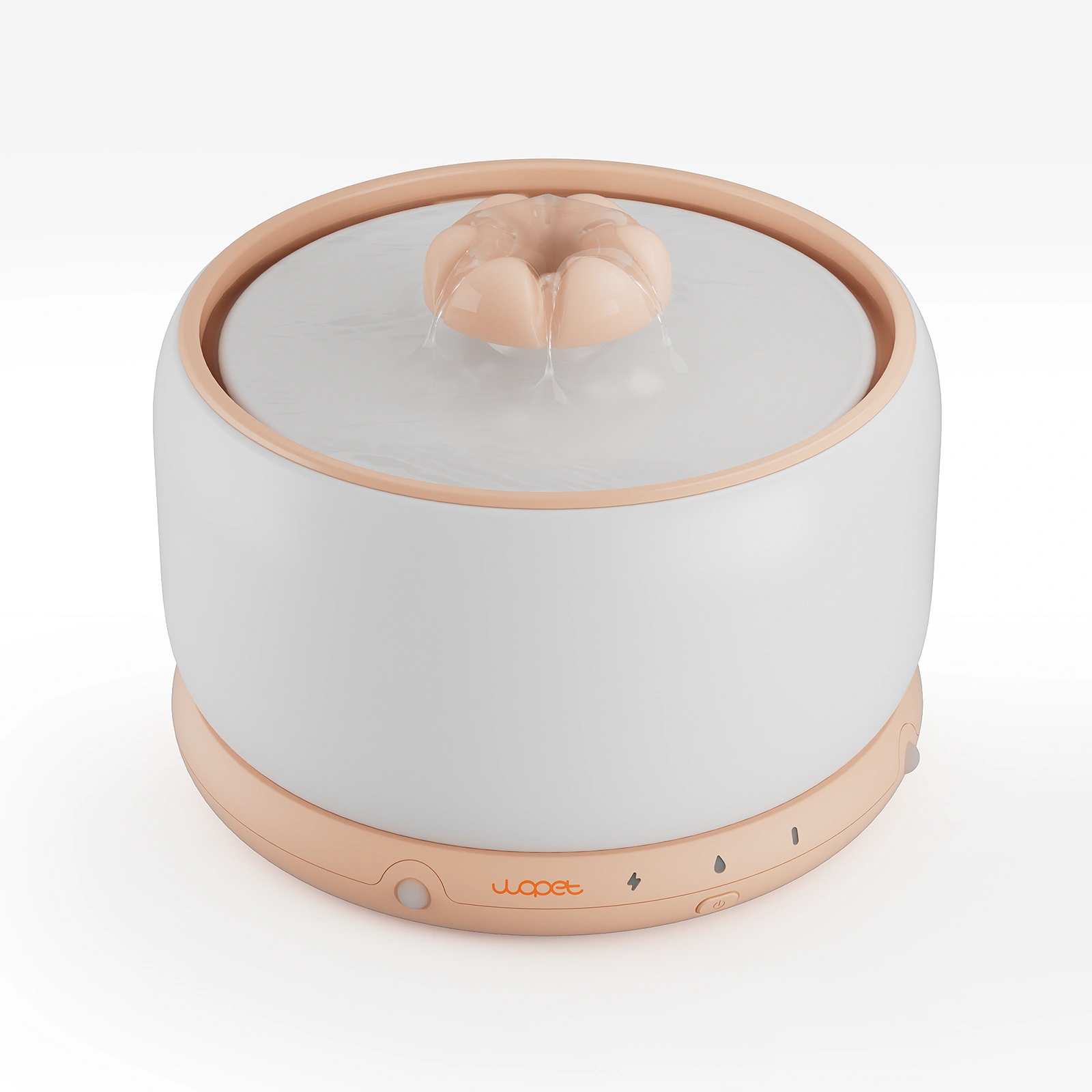
About WOPET W03
5000 mAh Battery: The cordless, battery-powered design means you can place the cat water fountain anywhere in your home, and the 5000 mAh battery provides up to 30 days of continuous use on a single charge.
Super Quiet Pump: This stylish and unique ceramic cat fountain is ultra-quiet (less than 25 decibels), and the sound of the pump is barely audible. It won't interfere with anything you do at any time, allowing you and your pet to get a good night's sleep.
High Quality Ceramic: This pet water fountain is made of high-quality, eco-friendly ceramic material with a stylish and modern design. It complements any home décor." High Quality Ceramic: This pet water fountain is made of high-quality, eco-friendly ceramic material with a stylish and modern design. It complements any home décor.
Easy To Install And Clean: The cat fountain is easy to assemble and disassemble for easy cleaning and replacement. The ceramic water bowl is dishwasher safe.
Multiple Filtering System: The ceramic cat water dispenser comes with an activated carbon filter and a sponge filtration system. The sponge filters out impurities, and the activated charcoal filter traps hair, removes odors, softens water, and improves taste, providing purer and fresher water for your lovely pet.
What You Will Get
WOpet Automatic Pet fountain x1
Power Adapter x1
Type-C Cable x1
User Manual Book x1
Specifications
Product Name
Ceramics Wireless Pet Water Fountain
Product Model
W03
Capacity
3L/101oz
Product Dimension
28.5*28.5*19.2 CM
COLOR
White Orange/White Blue
Battery Capacity
5000 mAh
Rated Voltage
110-240V
WOpet is committed to ensuring that pet owners can embrace boundless love for their pets by offering high-quality smart products that strengthen the bond between pets and their families.
Brand Story
WOpet was born from a moving homecoming one autumn evening in 2015. Our founder returned from a long trip to his eagerly waiting dog, sparking a deep realization about the emotional role he played in his pet's life. WOpet thus was created to ensure that pets receive not just care but also love and emotional companionship, even when their owners can't be physically present. Our smart, innovative solutions help strengthen the special bond between pets and owners, ensuring a connection that transcends distance. With WOpet, it's more than care; it's about maintaining a heartfelt bond.
Home Page : automatic cat feeder
Buy on WOPET : WOPET W03
WOpet 7L WiFi Automatic Cat Feeder With Camera Dog Food Dispenser丨Pioneer Plus
Food Tank Capacity
WiFi Network
Meal Range
Portions Range
Kibble Size Range
Each Portion Size
Pioneer Plus Pet Feeder-FV01 Plus
$99.99
(Current Model)
7L
5G / 2.4G
1-6
1-20
2-15mm
10g
Castle WiFi Pet Feeder-FW70 Plus
$59.99
Learn More
5L
5G / 2.4G
1-10
1-12
2-15mm
12g
Patrol Automatic Pet Feeder-F07 Pro
$79.99
Learn More
6L
2.4G
1-15
1-50
5-15mm
5g
About WOPET FV01 Plus
Smart APP Control: Remotely set times to feed your pet automatically, with WOPET wifi dog feeder you can set 1-6 meals per day and up to 20 portions of dry food per meal depending on your pet's needs. Allowing you to program and monitor your pet's meals anywhere anytime through the WOPET App for iOS and WOPET SMART App for Android phones.
Compatible with 2.4G and 5G. HD Camera: WOPET dog feeder automatic with camera allows you to see, hear how your beloved pet is eating when you're on the go. Connect with your pet while you are away with the supported audio chat/recording. Sharing your favorite moment on social media directly. Suitable Capacity: This 7L / 29cup smart pet feeder automatic consistently provides food for your cat and dog smoothly for a couple of day, assuring you that it' ll stay full and happy when you're out for a short vacation or work long hours.
10s Customized Messages: Record your voice messages and play it to make your pets get used to the feeder better while dispensing meals. The automatic dog feeder automatically broadcast to remind your pets that it's time for meal.
Backup Power Supply: Power is supplied to the automatic dog feeder with camera via included power adapter or 3*D batteries(not included). Battery backup ensures your pets get fed even in a power outage. We recommend using the two together in case of power outages.
What You Will Get
WOpet Automatic Pet Feeder x1
5V/1A Power Adapter x1
4.9ft Type-C Cable x1
User Manual Book x1
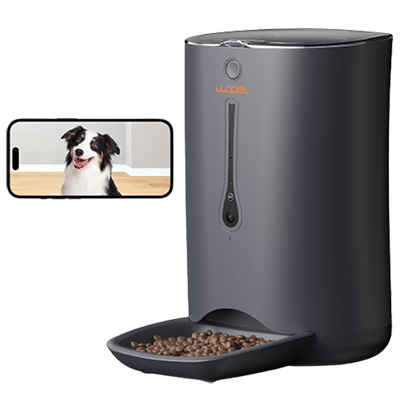
Specifications
Product Name
Pioneer Plus Pet Automatic Feeder
Product Model
FV01 Plus
Capacity
7L
Product Dimension
9.8 x 13.7 x 15.3 inch
Camera
120° Wide Angle Lens HD Camera
Food Container
29cups
Rated Voltage
110-240V
WOpet is committed to ensuring that pet owners can embrace boundless love for their pets by offering high-quality smart products that strengthen the bond between pets and their families.
Brand Story
WOpet was born from a moving homecoming one autumn evening in 2015. Our founder returned from a long trip to his eagerly waiting dog, sparking a deep realization about the emotional role he played in his pet's life. WOpet thus was created to ensure that pets receive not just care but also love and emotional companionship, even when their owners can't be physically present. Our smart, innovative solutions help strengthen the special bond between pets and owners, ensuring a connection that transcends distance. With WOpet, it's more than care; it's about maintaining a heartfelt bond.
Buy on Amazon : WOPET FV01 Plus
Buy on WOPET : automatic cat feeder
WOpet Cube Air WiFi Pet Feeder
Feature
Food Tank Capacity
Meal Range
Portions Range
Allowed Kibble Size
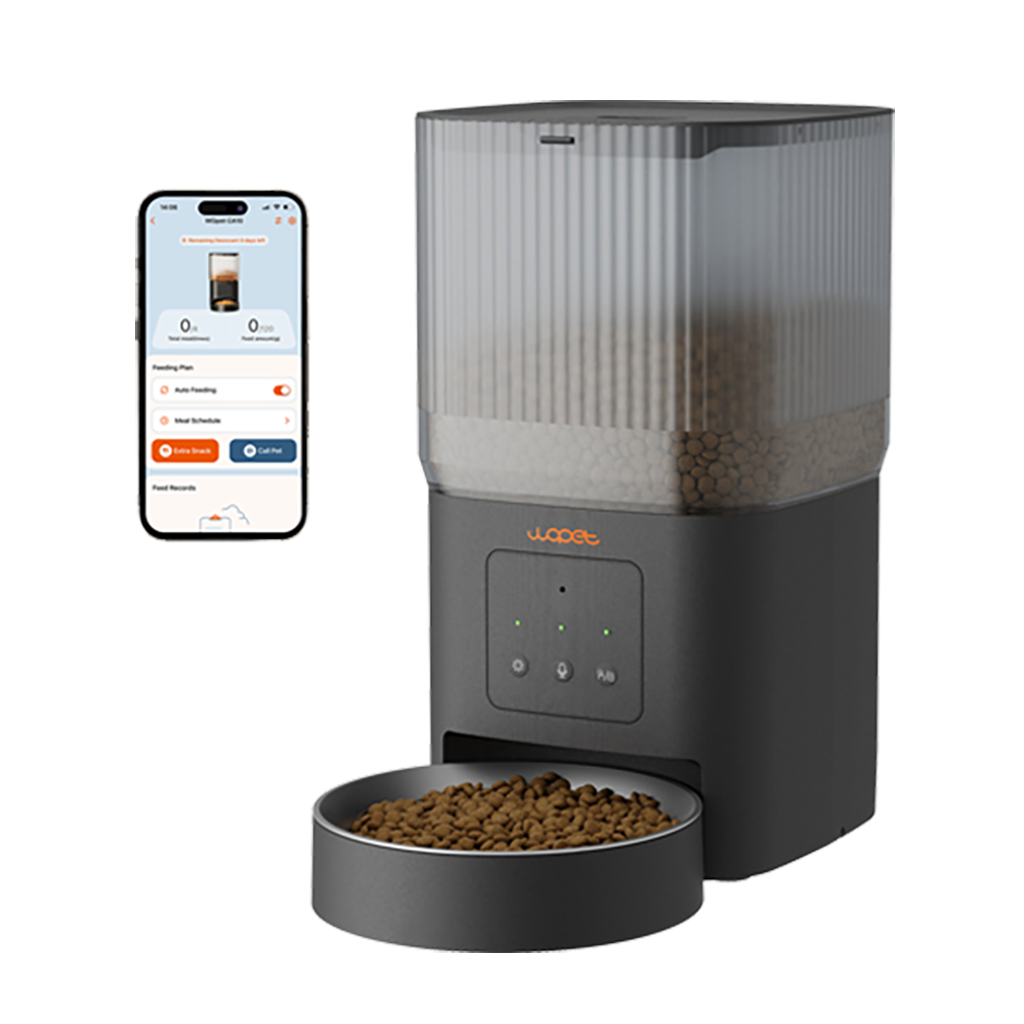
Cube Air WiFi Pet Feeder-CA10
$49.99
(Current Model)
App Control
4L
1-10 Meals
1-8 Portions
2-12mm
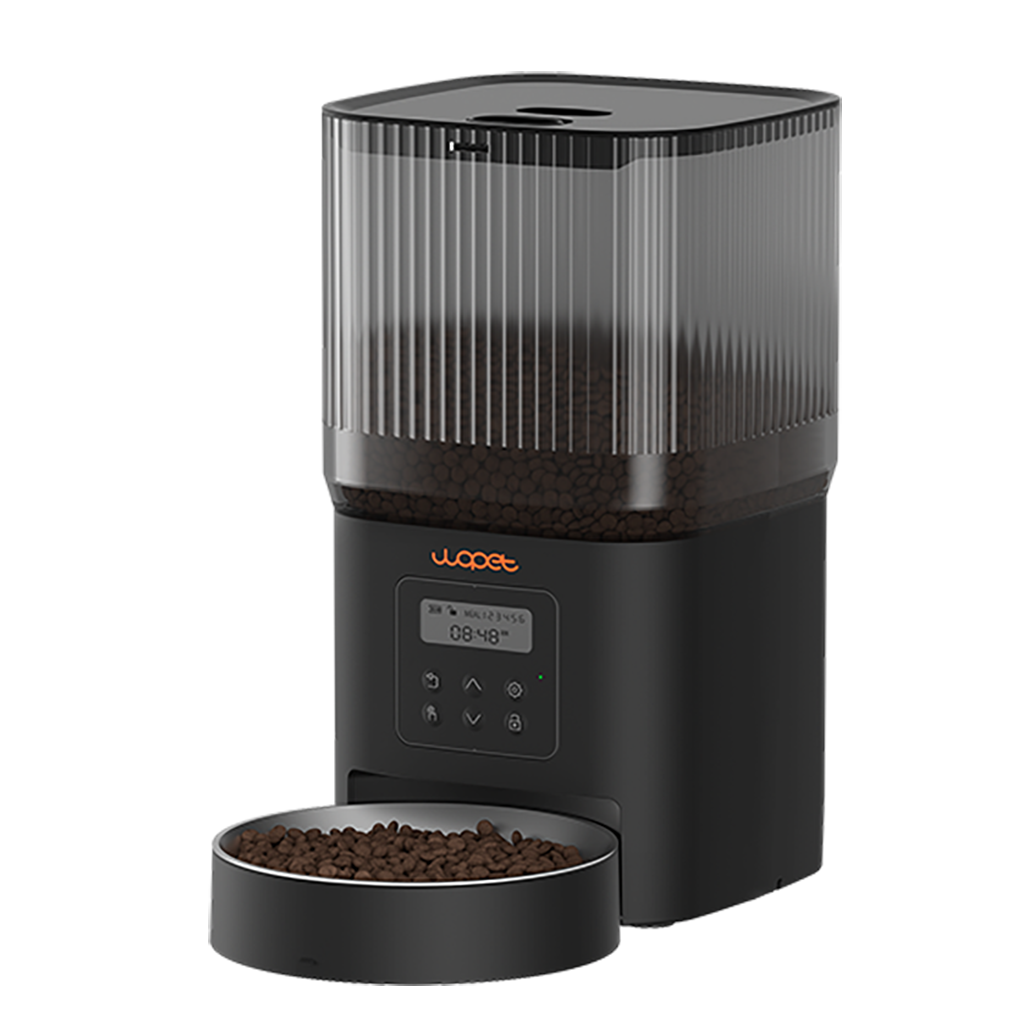
Cube Lite Automatic Pet Feeder-CL11
$39.99
Basic
4L
1-6 Meals
1-8 Portions
2-12mm
About WOPET CA10
【Easy to Set – 10 Grams per Portion, 1-8 Portions per Meal, 1-10 Meals per Day】WOpet Automatic Cat Feeder Connect effortlessly to your 2.4GHz network(only 2.4GHz, not compatible with 5GHz) and take charge of your pet's feeding routine with your phone. You can set up to 10 meals per day with 1-8 portions per meal and track the feeding logs easily by using the “WOpet Life” APP,give different age groups of different pets the best health feeding.
【Healthy Eating, One Bite at a Time】:Enable the slow feed mode in the WOpet Life APP, which helps prevent health problems such as bloating, overeating, and obesity in pets. Additionally, it assists in managing food aggression and training pets for calmer,more controlled meal times.
【Personalized Voice Meal Call】The Wopet pet Automatic feeder allows you to record up to 10 seconds of voice messages A familiar voice of the pet's owner helps alleviate their anxiety and allow them to eat peacefully when you are not around. Your phone would receive notifications when the feeding completes, the food tank is empty,the tank is jammed,the battery is low,or other problems.
【4L Capacity – Cats Can Eat 24 Days、Small Dogs 14 Days】: 4L = 16.9Cup = 135.26oz. In order to ensure that the capacity is large enough at the same time, to fully ensure that the feeder food fresh, dry, easy to clean, (if less than 4L, can not meet the long time to travel and often need to add food; if greater than 4L, the capacity is too large at the same time, the food stored inside for too long, contact with the air for too long, and It is not easy to observe the state of the food, food, oil and other substances for a long time plus the accumulation of air contact, inconvenient to clean, easy to cause clogging and even food spoilage,and so many reasons.
【After-sale Service – Product List】NO Risk-Purchase: We offer return and exchange within one year (orders over one year, if there is any problem, you can contact us to deal with it), as well as 24 hours human online customer service. √ Product List: 1*Feeder+1*Power Adapter +1*Type-C Power Cable+1*Desiccant+1*Stainless Steel Bowl+1*User Manual.
What You Will Get
Instruction Manual x1
WOpet Automatic Pet Feeder x1
Stainless Steel Bowl x1
Desiccant Bag x1
5V/1A Power Adapter x1
4.9ft Type-C Cable x1

Specifications
Product Name
WOpet Cube Air Pet Feeder
Product Model
CA10
Product Dimensions
7 x 7 x 13 inches; 3.09 Pounds
Capacity
4L
WOpet is committed to ensuring that pet owners can embrace boundless love for their pets by offering high-quality smart products that strengthen the bond between pets and their families.
Brand Story
WOpet was born from a moving homecoming one autumn evening in 2015. Our founder returned from a long trip to his eagerly waiting dog, sparking a deep realization about the emotional role he played in his pet's life. WOpet thus was created to ensure that pets receive not just care but also love and emotional companionship, even when their owners can't be physically present. Our smart, innovative solutions help strengthen the special bond between pets and owners, ensuring a connection that transcends distance. With WOpet, it's more than care; it's about maintaining a heartfelt bond.
Buy on Amazon : WOPET CA10
Buy on WOPET : automatic pet feeder
Top 8 Benefits of Using a Cat Slow Feeder
Are you tired of your furry friend scarfing down their meals in mere seconds, only to suffer from digestion issues or beg for more food soon after? If so, it might be time to consider investing in a pet slow feeder. These innovative feeding solutions offer a myriad of benefits for both you and your beloved pet. Let’s delve into the top 8 advantages of incorporating a pet slow feeder into your furry companion’s mealtime routine.
Top 8 Benefits of Using a Cat Slow Feeder
With the growing concern over pet obesity, feeding habits have come under scrutiny. Fast eating can lead to a range of health issues, from digestive problems to obesity. Cat slow feeders offer a solution by encouraging pets to eat at a more measured pace, promoting better digestion and overall health. Let's dive into the reasons why you should switch to a slow feeder.
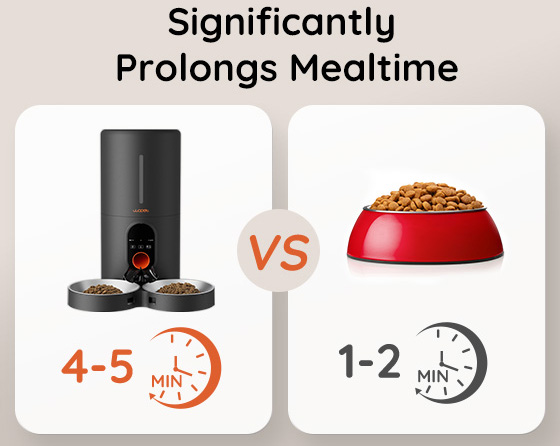
1. Improved Digestion:
Slow feeding isn't just about pacing your pet's mealtime; it's also about enhancing their digestion. By slowing down their eating, slow feeders allow pets to chew their food more thoroughly, which aids in digestion. This is particularly beneficial for pets prone to gastrointestinal issues, as it reduces the likelihood of digestive upset and discomfort.
2. Weight Management:
Maintaining a healthy weight is crucial for your pet's well-being, yet many struggle with overeating. Slow feeders act as portion control devices, helping regulate food intake and prevent overconsumption. By slowing down the eating process, they give pets the chance to recognize when they're full, reducing the risk of obesity and its associated health problems.
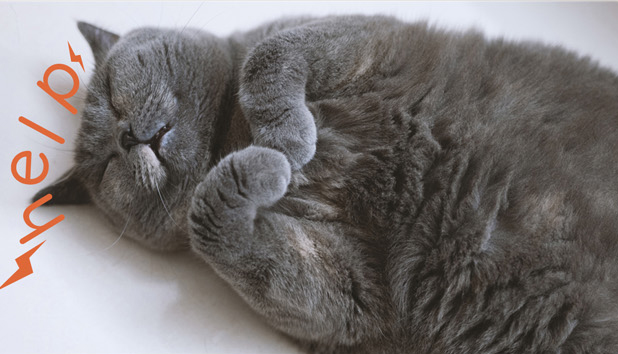
3. Mental Stimulation:
Mealtime shouldn't just be about nourishment; it should also provide mental stimulation for your pet. Slow feeders accomplish this by mimicking natural foraging behavior, engaging your pet's mind as they work to extract their food from the intricate designs of the feeder. This mental challenge adds an extra layer of enrichment to mealtime, keeping your pet engaged and satisfied.
4. Slows Down Eating:
The dangers of fast eating in pets cannot be overstated. Rapid consumption increases the risk of choking, gagging, and even life-threatening conditions like bloat. Automatic slow feeders promote safer eating habits by forcing pets to take their time and chew their food thoroughly, reducing the likelihood of these dangerous incidents.
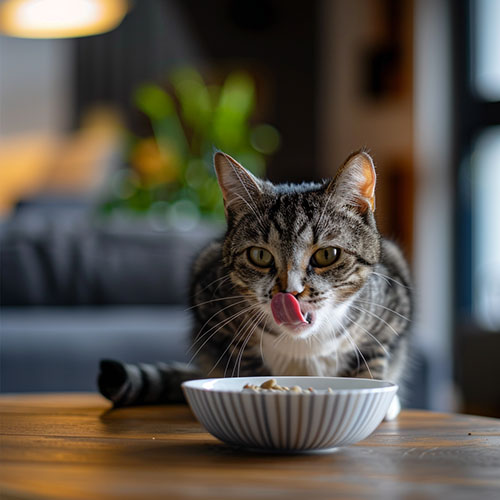
5. Prevents Food Aggression:
In multi-pet households, mealtime can sometimes become a battleground, with pets vying for control over food resources. Slow feeders help alleviate food aggression by encouraging each pet to focus on their own meal, rather than competing with others. By providing a structured eating environment, the feeders promote harmony and reduce tension during feeding times.
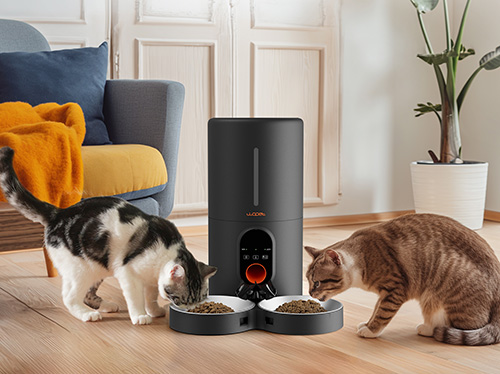
6. Increases Mealtime Enjoyment:
Who said mealtime has to be mundane? Slow feeders turn feeding time into a fun and interactive experience for your pet. Watching them navigate the twists and turns of the feeder to access their food can be both entertaining and rewarding. Many pet owners report an increase in their pet's enjoyment of mealtime after making the switch to a slow feeder.
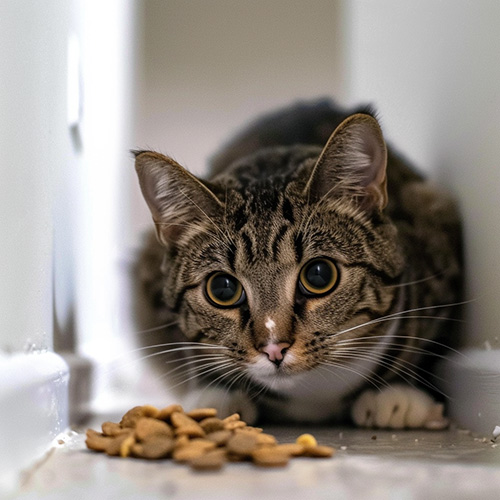
7. Supports Dental Health:
Dental health is a crucial aspect of your pet's overall well-being, yet it's often overlooked. Slow feeder for cats promote better dental health by encouraging pets to chew their food thoroughly, which can help prevent tartar buildup and gum disease. By incorporating dental care into mealtime, slow feeders contribute to your pet's long-term oral health.
8. Reduces Anxiety:
For some pets, mealtime can be a source of anxiety, particularly if they feel rushed or overwhelmed. Slow feeders provide a calming activity that can help reduce mealtime anxiety. By focusing their attention on the task of extracting food from the feeder, pets can relax and enjoy their meals without feeling stressed or anxious.
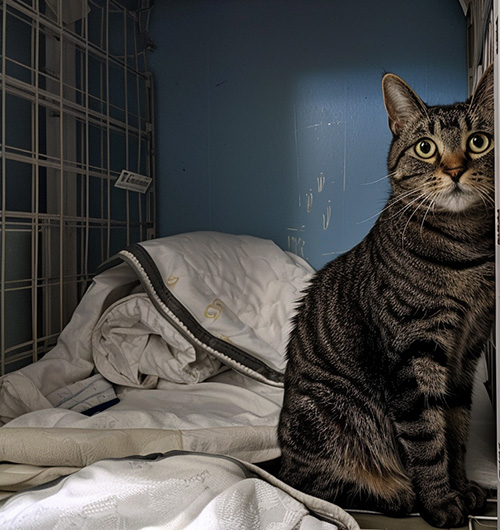
Conclusion:
Whether you're looking to promote better digestion, manage their weight, or simply add some excitement to mealtime, slow feeders offer a range of benefits that can make a real difference in your pet's life. So why wait? Take the first step towards a healthier, happier pet by investing in a slow feeder today.
Source: https://wopet.com/cats/benefits-of-using-a-cat-slow-feeder/
